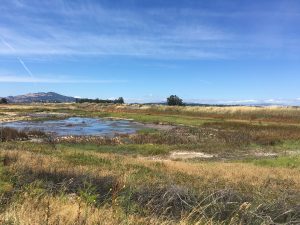The start to my summer at the California State Coastal Conservancy has been an exciting one with attending meetings, meeting the movers and shakers of conservation and climate adaptation in the state, conducting interesting research, and visiting projects.
Last week, I had the opportunity to attend a board meeting of the San Francisco Bay Restoration Authority (SFBRA). For a bit of background, the SFBRA is a regional agency created in 2008 by the California Legislature. The SFBRA is charged with raising and allocating resources for the restoration, enhancement, protection, and enjoyment of the San Francisco Bay wetlands and habitats, and associated flood management and public assess infrastructure (http://sfbayrestore.org/).
Measure AA, a $12 parcel tax to fund these projects, passed with a 70% majority of Bay Area residents last summer. This measure will raise $500 million over 20 years to restore the bay.
This particular board meeting was at the Marin County Civic Center, a Frank Lloyd Wright designed building in San Rafael. As we made our way to the board room, we passed under a glass roof, through long hallways with pink stucco walls and gold trim – it was unlike any government building I’d ever been in before. Once we reached our room, we had a spectacular view of the surrounding area.
This was my first governmental board meeting of any sort, so I was enthralled with even the procedural elements and set up. The meeting kicked off with the call to order, roll call, public comments, approval of the previous meeting’s minutes, and announcements. However, the floor was soon turned over to Sam Schuchat, Executive Officer at the California State Coastal Commission, who conducted Workshop #4 of the Bay Restoration Series, a set of workshops meant to educate board members on the history, successes, and challenges of restoration around the bay.
Workshop #4 opened our eyes to a long-term restoration project down the road from us in Marin County: the Hamilton Wetlands Restoration Project (which we were lucky enough to visit, scroll down for photos). Located on the former Hamilton Army Airfield, the marshes in this area were historically diked, drained, and farmed, causing subsidence. This left the land too low for wetland natives to become established. To account for this subsidence, approximately 6 million cubic yards of dredged sediment from the Port of Oakland was placed on the project area between 2008 and 2013 to create tidal marsh. At this point, this was the largest beneficial reuse of dredged sediment (which normally would have been disposed of in the ocean). A year later, the levee was breached reconnecting the former airfield to the bay. Since, native plans and wildlife have repopulated the area as tidal marsh has become reestablished. A horizontal levee was created in the dispersion of the dredged sediment, affording the residents of the area natural flood protection as sea level rises. The Bay Trail also passes through this wetland, allowing the public to enjoy the area (http://hamiltonwetlands.scc.ca.gov/).
After this workshop, project manager at the State Coastal Conservancy (and MIIS alum!), Kelly Malinowski presented on the updated project list of potential projects eligible for Measure AA funds. This was followed by a discussion and approval of the Grant Program Guidelines and a presentation of the draft Request for Proposals.
After the meeting was adjourned, we visited the Hamilton Wetlands Restoration Project where we were able to walk along the Bay Trail and enjoy the interpretive signs, listen to an audio tour of the local natural history, and walk to a vista point to see the tidal marsh reestablishment.
This marked the end of a great first week at the California State Coastal Conservancy. I am looking forward to what the rest of the summer holds!







Now I want to check out that building. Pro tip: next time you are in San Rafael, check out Sol Food for some delicious Puerto Rican noms. #eatyourwayaroundthebay
I have walked that trail too! Your story shows that the land is so remarkable, so able to recover a natural balance if allowed to do so. This gives me great hope. Thanks for putting your efforts towards this good stuff!